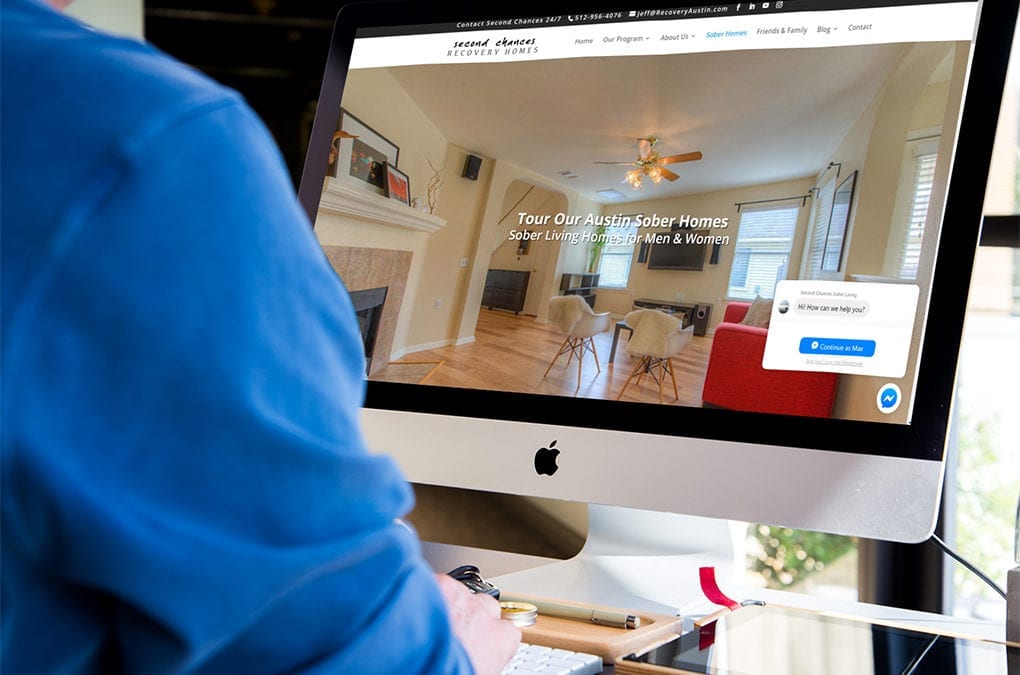Skip Ahead to Topic
Sober Living in Austin Texas
Most of us are very familiar with the term “rehab” (short for drug rehabilitation center), thanks largely to entertainment news reports that so often feature the addiction struggles of celebrities. But there are so many terms associated with addiction recovery housing, many of which overlap and confuse those seeking help. What exactly is a sober living home? How is it different from a rehab center or halfway house? What sets Second Chances Recovery Homes (SCRH) apart from its competition? The purpose of this article is to help you navigate the answers to those questions.

Options on the Road to Wholeness
Rehabilitation centers
Rehabilitation centers are generally the drug or alcohol addict’s first stop on the road to recovery. They specialize in treating people new to recovery and therefore offer more acute interventions than other recovery settings, such as supervised detoxification from the abused substance and 24-hour medical and psychiatric care. Both inpatient and outpatient services may be offered, with an initial 30- to 90-day stay recommended for those with longstanding or severe addictions, or addictions to more than one substance. An inpatient stay is often followed by outpatient care that allows the addict to return to living at home while continuing part- or full-time treatment.
Rehabilitation centers are designed to be restrictive, immersive environments where an addict’s entire focus is on ridding his or her body of harmful drugs and initiating the recovery process. Individual and group therapy, as well as medical and psychological care, all play a part in helping the addict to separate from a drug and/or alcohol dependent mindset and lifestyle. For most, rehab is a launching pad for recovery – the first of many steps.
Halfway Houses
Halfway houses, along with sober living homes, fall under the umbrella term “recovery residence.” A recovery residence is exactly what it sounds like: a living environment, that supports recovery from alcohol and drug addictions. While it’s possible for an addict to enter some recovery residences without having completed a stint in rehab, facilities like halfway houses and sober living homes are often seen as a bridge between the acute care rehab provides and a full return to normal life.
Halfway houses provide a drug and alcohol-free, structured living space where addicts can continue to receive some level of treatment while easing back into work and independent living. These homes promote sobriety through required or strongly encouraged involvement in 12-step groups like Alcoholics Anonymous (AA) or Narcotics Anonymous (NA), peer support from other residents, and the accountability of nightly curfews and living space inspections. House rules such as maintaining abstinence, contributing to the upkeep of the home through assigned chores, and regular payment of rent help recovering addicts to practice personal responsibility and stay focused on their recovery and life goals.
Halfway houses are similar to sober living homes (in fact, the terms are sometimes used interchangeably), but with some disadvantages. Because they are often government-funded, halfway houses are more likely to limit how long residents can stay, which means people can be forced to move out before they are ready. Halfway houses are also more vulnerable to budget cuts that can leave residents without anywhere to go but back to unsafe environments likely to trigger another relapse.
The admissions requirements at a halfway house may be stricter, as well. Some halfway houses want residents to have first completed a rehab program or be actively in treatment. Such requirements may exclude from care those who have had negative rehab experiences in the past or who are interested in pursuing alternative care options. Finally, because the term “halfway house” is also used to refer to transitional housing for ex-felons recently released from prison or to homes for people with mental disabilities, unnecessary stigma and embarrassment may be attached to living in such a facility.
Get in a Sober Living Home Today. Call 512-265-5311
Need more information about our medically assisted treatment friendly program?

What are Sober Living Homes?
In recent years sober living homes (SLH’s) have become a more popular option for those in recovery seeking extended transitional support. These homes are usually privately owned and therefore free of the funding limitations and other restrictions that can handicap a halfway house. At minimum, they provide the same living space and structure and support as halfway houses. Many actually go above and beyond in catering to their clients’ preferences and individual needs.
Greater flexibility in tailoring treatment plans is one perk of sober living homes. Some are able to accommodate medications prohibited at other treatment facilities; some allow substitutes for required 12-step groups; and some can offer varying levels of support (counseling and mentoring services) according to the individual resident’s needs. An SLH’s flexibility often extends into length of stay for recovering addicts, with many placing no limitations on residency as long as house rules are abided by. An open-ended invitation to live in a clean, supportive environment can relieve undue stress on “what next?” and make this type of residence feel much more like a home.
Finally, while the framework of the AA-style accountability group, house expectations, and accessible support services is the same as a halfway house, the “extras” are what make SLHs more like a mansion for healing than the mere house—or, sometimes shack—offered up by its counterpart. Scheduled volunteer and leisure outings, exercise classes, upscale accommodations with modern amenities, locations in attractive residential settings, and other perks make sober living homes the recovery residence of choice for those trying to get back on their feet and learn to live again.


Sober Living at Second Chances Recovery Homes
As the sober living home has become a more popular recovery option, the number of these residences has exploded. But what does a first-class sober living home look like?
Anyone seeking a sober living home in Austin, Texas would do well to look to Second Chances Sober Living as the standard-bearer in quality care. Every facet of life at Second Chances is designed to promote physical, mental, spiritual, and social well-being.
-
Individual-tailored, holistic (whole-person) treatment
At Second Chances, residents enjoy a balance of freedom and structure tailored to their specific stage in the recovery process and their individual needs. There is no one-size-fits-all mindset here. What works is what matters. Tools, groups, and professionals that support mind, body, and spirit healing are all brought to bear in the quest for sober wholeness.
-
Full continuum of care
Second Chances is by your side through from Day One of the recovery process. Staff members are available to pick up individuals and transport them to a 24-hour detox, and from there, to an inpatient facility, if needed. Partial hospitalization programs (PHPs) and drop-down services such as intensive outpatient treatment are all supported by the Second Chances recovery experience.
-
Medication-Assisted Treatment
Medication-assisted treatment (MAT) in conjunction with other therapies is a proven tool in the fight to win the war against addiction to opioids, alcohol, and even smoking. Second Chances is one of the few sober living homes with the infrastructure to support this option for its residences. The highly-qualified staff may prescribe and safely monitor medications such as Soboxone, which supports opioid-addiction recovery.
-
Quality Medical Care
Second Chances offers professionally delivered clinical services, from its own pharmacy to a network of preferred doctors. A certified “addictionologist”, psychiatrist, and therapist are all available, sparing the resident the hassle and headache of “shopping around” for the right medical support team.
-
Solid Support
Community – the right kind of community – is key to the healing process at Second Chances. SCRH staff and assigned mentors provide guidance and accountability through the steps of recovery–from overcoming withdrawals to getting a good job. Residents are urged to support and encourage each other as well, thereby creating an atmosphere of care, concern, and goodwill in the home.
Connections to the greater recovery community in Austin are also fostered through AA meetings, events with Austin’s ATX Recovery, and relationships with other groups and businesses like Austin-based Clean Cause.
-
Upscale Accommodations
The comforts of home can be a difference-maker in the often uncomfortable process of getting clean. Second Chances Recovery Homes provides clean, beautiful, private environments with all the modern conveniences necessary to help residents focus on recovery.
Homes for men and women come equipped with on-site washers and dryers, large common areas, fully equipped kitchens, and free Wi-Fi. These homes are located close to many Austin attractions, including coffee houses, shopping centers, popular live music venues, parks, and amazing restaurants. At Second Chances, it’s possible to still enjoy life while on the road to recovery.
-
Open Doors
Unlike many sober living homes, Second Chances takes a recovering addict as early as just one day sober in its Foundation and women’s homes. The length of stay is open-ended, with SCRH’s graduate home as a luxurious final step-down option for those wanting to extend their residential recovery experience. Real-life readiness is important to long-term sobriety, and Second Chances works with each resident to ensure the necessary support is available as long as it’s needed.
Discover the life-changing difference that a quality sober living home can make in your recovery. Take that first step toward “wholeness with help” by contacting Second Chances today.


Recent Comments